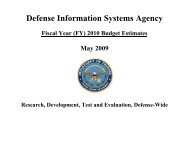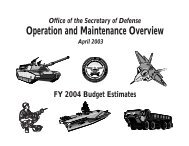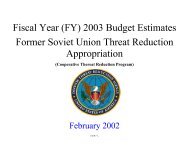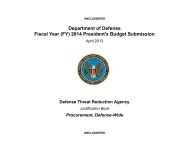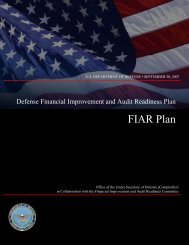department of defense agency financial report fiscal year 2012
department of defense agency financial report fiscal year 2012
department of defense agency financial report fiscal year 2012
You also want an ePaper? Increase the reach of your titles
YUMPU automatically turns print PDFs into web optimized ePapers that Google loves.
Department <strong>of</strong> Defense Agency Financial Report for FY <strong>2012</strong><br />
corrective actions. The Department is committed to complying with all laws and<br />
regulations established to reduce improper payments. As <strong>report</strong>ed in DoD IG Report<br />
No. D-<strong>2012</strong>-065, the Department is compliant with the requirements <strong>of</strong> the Improper<br />
Payments Elimination and Recovery Act (IPERA). Beginning in FY <strong>2012</strong>, the Department<br />
instituted statistical sampling for commercial payments disbursed by DFAS.<br />
Since the Department first <strong>report</strong>ed on improper payments in the FY 2004 Performance<br />
and Accountability Report, improper payment rates have declined. The Office <strong>of</strong><br />
Management and Budget (OMB) <strong>report</strong>ed the government-wide FY 2011 error rate for<br />
improper payments at 5.49 percent, which is substantially higher than each <strong>of</strong> DoD’s<br />
programs 1 . Further, OMB has not designated any <strong>of</strong> DoD’s programs to be a high error<br />
program, as shown on the PaymentAccuracy.gov web site.<br />
The Department does not agree with the IG’s statement that deficiencies in the<br />
Department’s initial High Dollar Improper Payment Report, as <strong>report</strong>ed in DoD IG Report<br />
No. D-2011-050, present a significant management challenge. The cited <strong>report</strong> was<br />
based on information from Quarter 3, FY 2010 – more than two <strong>year</strong>s ago, and all<br />
13 open recommendations have been successfully closed.<br />
The Department does not have a “pay and chase” practice, as cited above by the<br />
DoD IG, where contractors are paid before the Department determines the correct<br />
billing. In Audit Report No. D-2011-050, the DoD IG used the phrase, ‘pay and chase’<br />
when referring to a DFAS review <strong>of</strong> travel pay among different systems. The DCAA<br />
performs risk-based voucher reviews to proactively keep contractor billings aligned with<br />
final amounts and rates, not ‘pay and chase,’ and it is an important part <strong>of</strong> the<br />
Department’s audit readiness efforts. The DCAA is diligently working to reduce its<br />
current audit inventory and is making progress.<br />
2. IG-Identified Challenge: Acquisition Processes and Contract<br />
Management<br />
2-1A. Enhancing the Acquisition Workforce IG Summary <strong>of</strong> Challenge<br />
The Department continues to struggle with its efforts to rebuild an acquisition workforce<br />
that is sufficient in size and adequately trained and equipped to oversee DoD<br />
acquisitions. Even though the Defense acquisition workforce has grown over the last few<br />
<strong>year</strong>s, the Department still faces significant challenges in order to sustain a successful<br />
and well trained Defense acquisition workforce. These challenges include: 17 percent <strong>of</strong><br />
the acquisition workforce is eligible for full retirement today; 19 percent are eligible<br />
within 5 <strong>year</strong>s; and personnel losses spiked up 3 percent from FY 2010 to FY 2011. The<br />
Department needs to continue to provide developmental opportunities to the Defense<br />
acquisition workforce to have personnel who can successfully manage complex<br />
acquisition programs in the Department. Regardless <strong>of</strong> the looming decline in the<br />
Defense budget, the vital role the acquisition workforce plays in providing the<br />
warfighters with new capabilities will remain. Previous Defense budget cuts decimated<br />
the capability <strong>of</strong> the acquisition workforce; a mistake the Department can ill afford to<br />
repeat.<br />
1 The Fiscal Year 2011 DoD Agency Financial Report showed the overall Department error rate at 0.18 percent;<br />
however, DFAS commercial payments included in this figure were an actual amount, not a statistical estimate.<br />
A-9<br />
Addendum A



